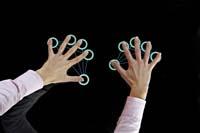New forms of mobile web browsing (II): Multimodal access
What is multimodal access?

Multimodal access is defined as multiple interoperability with a system. In conventional computers keyboard and mouse are usually used, but there are other means such as remote controls, touch screens, voice... And at the level of research there are other eye, mental and body movements, sign language, electric brain signals...
These capture modes often improve usability: for example, to interact from the sofa with a video recorder is more appropriate to use the remote than a keyboard and mouse; or to operate on a mobile phone only these small keyboards can give voice commands. But they also serve to improve accessibility in cases of disability or disability: through a voice interface, the blind can use a computer; or in cases of deep disability, eye movements or cerebral electrical signals can be used as an interface.
There are devices that implement such interfaces, but they need special software to interpret and send our commands, which is not valid for all systems. Therefore, W3C is trying to standardize protocols for certain access modes so that browsers can implement these standard protocols and use these new access types when browsing on any device.
Voice navigation
To interact with a mobile phone and be able to surf the Internet, it is very appropriate to give orders through the voice. On the one hand, all phones have a microphone and we are used to using the voice with it. On the other hand, these are small devices with small keyboards, or simply numeric keyboards, in which you have to press many keys to write a single letter, or the keyboards that overlap on the touch screen are small and uncomfortable (for letters, numbers and symbols you have to change from one keyboard to another). Finally, the most advanced devices also have GPS applications, where it is essential to have your hands free.
The W3C has a standard called VoiceXML that serves voice applications and is interpreted through a voice browser. It has many applications: call-center, package tracking in transport companies, voicemail... But this standard only uses voice, commands are given with voice recognition and voice synthesis responses.
Based on a subset of this VoiceXML and HTML, IBM, Motorola and Opera defined the XHTML+Voice protocol for visual and voice web applications and sent it to the W3C organization for approval as standard. At the moment it is not approved, but since with HTML5 web applications go beyond the field of vision, they may be accepted in the future. In any case, the Opera browser has it implemented, so it is now possible to make web applications that integrate vision and voice for mobile phones or computers that use this browser.
Manual gestures
On the other hand, mobile devices have also introduced new forms of touch navigation. So far the actions that have been carried out with the mouse have basically consisted of clicking, double clicking and dragging and dropping. Most touch screens interpret these same actions. But the iPhone popularized the so-called hand winks: being able to perform different actions depending on the movement of the fingers, such as turning a photo, and being able to use more than one finger, such as the distribution of two fingers together to zoom in. Since most mobile devices that allow browsing the Internet have a touch screen and are increasingly seen in home computers or other leisure devices, it would be very interesting to use this type of gesture in web applications. Manual single-finger gestures can also be used with the mouse.
The W3C has a standard called InkML. It is the language in which the introduction of tablets to draw in origin is described, but it also serves to describe the gestures and movements made on a touch screen, to then interpret them and convert them into actions. Although not yet developed enough, as it is a standard of W3C, it is logical that in the future this standard can be used also in navigation and therefore also in browsers manual gestures can be used.
In view of the lines of work of the W3C, it seems that in the future the trends that come from the mobile web, voice navigation and manual gestures will be seen more and more in internet browsers. When this happens, the Internet experience will be similar to the one seen in Minority report.






